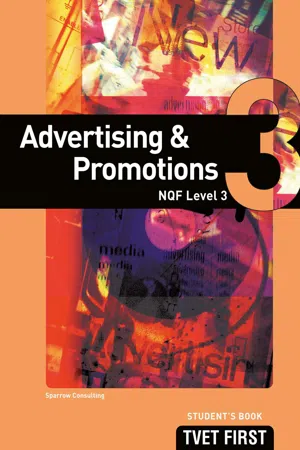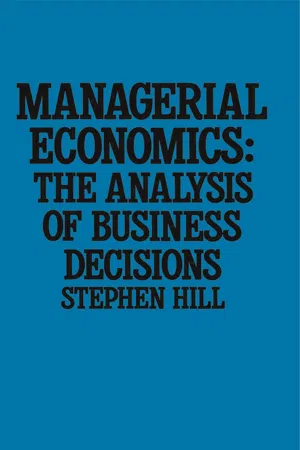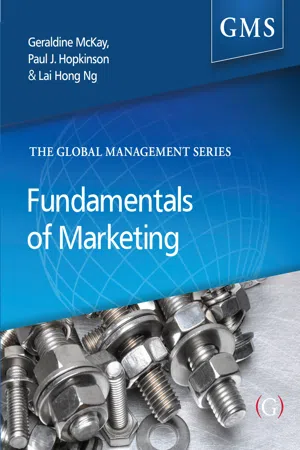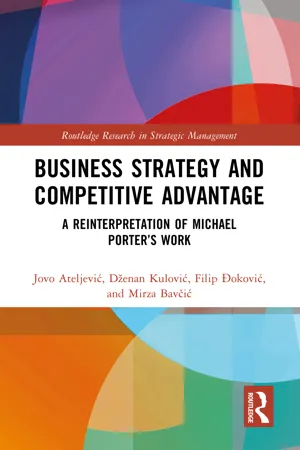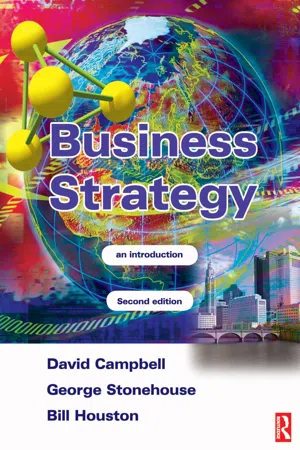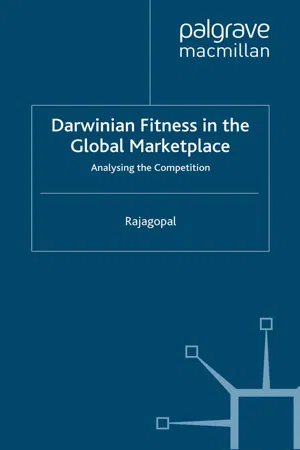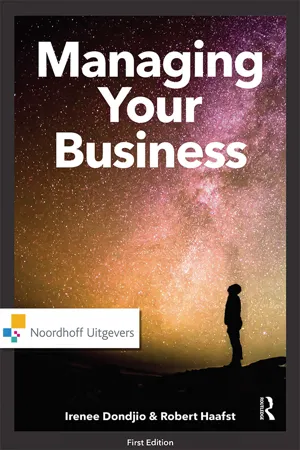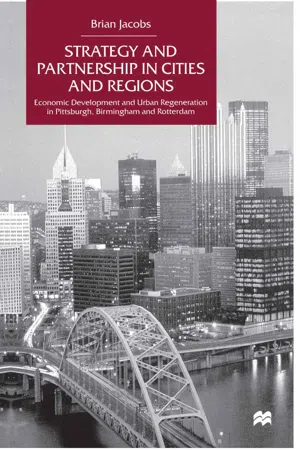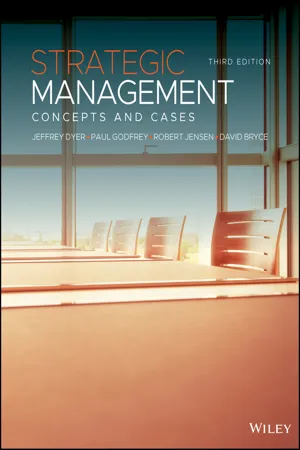Business
Competitive Environment
The competitive environment refers to the dynamic landscape in which businesses operate, characterized by the presence of rival companies vying for market share, customers, and resources. It encompasses factors such as industry competition, market saturation, and the impact of new entrants and substitutes. Understanding and adapting to the competitive environment is crucial for businesses to thrive and maintain a competitive edge.
Written by Perlego with AI-assistance
Related key terms
1 of 5
12 Key excerpts on "Competitive Environment"
- eBook - PDF
Advertising & Promotions NQF3 SB
TVET FIRST
- Sparrow Consulting(Author)
- 2013(Publication Date)
- Macmillan(Publisher)
Topic 4 Understanding the Competitive Environment Module 10 138 Module 10: Explaining the nature and extent of the Competitive Environment Explaining the nature and extent of the Competitive Environment Overview At the end of this module, you should be able to do the following: • Identify and explain issues regarding the Competitive Environment (Unit 10.1). • Identify and explain strengths and weaknesses of the Competitive Environment (Unit 10.2). • Identify and explain organisational tactics to match competitive strategies (Unit 10.3). • Identify and explain roles and responsibilities of team members within the Competitive Environment (Unit 10.4). Introduction What is the Competitive Environment ? This is the environment in which two or more companies work and compete against each other to be the best. In other words, it is where healthy business takes place. In a Competitive Environment, companies are constantly competing against each other and it is an ongoing process. Unit 10 .1: Issues in the Competitive Environment The Competitive Environment is defined as the number and strength of the competitors in a market. It is constantly changing – this is because organisations are continually implementing strategies to improve their standing in the market, which forces their competitors to increase their efforts. This means you will constantly have to analyse the Competitive Environment. Many businesses fail because of a lack of interest in what their competitors are doing. It is very important to be aware of what other businesses in your field are doing. For example, if a rival company has a brilliant new plan to sell its products and you become aware of this, you could create a strategy that will overrule theirs, so that it does not damage your business. Ultimately, the main aim of doing business is to make money. If you do not compete successfully in the competitive business environment, you will not succeed in making money for your company and for yourself. - eBook - PDF
Managerial Economics
The Analysis of Business Decisions
- Stephen Hill(Author)
- 2016(Publication Date)
- Red Globe Press(Publisher)
CHAPTERS The co111petitive environment Contents INTRODUCfiON 183 THE DIMENSIONS OF COMPETITION 185 FORMS OF MARKET STRUCfURE 188 OLIGOPOLY 191 MONOPOLY 192 THE MEASUREMENT OF COMPETITION 195 EMPIRICAL EVIDENCE 198 COMPETITION POLICY 201 SUMMARY AND CONCLUSIONS 202 APPLICATION 8 204 Introduction Whilst demand and cost information are crucial to the firm's decision-making process, the extent and nature of competition define the external environment in which the firm operates. An understanding of this Competitive Environment will enable cost and demand analysis to be put together to determine an economic theory of the firm, which can offer significant insights into the decision-making process. Each and every business decision must be made in the light of anticipations about competitors' actions and reactions. The extent of competition influences the nature of both cost and demand conditions. Moreover, the competitive environ-ment defines the discretion that the firm's managers have over pricing, marketing, input purchase and other decisions. An under-standing of that decision environment is essential for both describ-183 184 Managerial Economics ing the limitations of market behaviour, and analysing the opportu-nities available in the market. The Competitive Environment is not stable, but rather is continuously changing. The relationship of the firm to its environment is both reactive and proactive -reactive in that the firm must respond to changes in that environment, and proactive in that the firm, by a judicious choice of policies, may influence that environment in ways that can increase the market opportunities available. The purpose of this chapter is to examine the dimensions of competition that define the firm's market environment, and con-sider the impact of each dimension on the firm's decisions. The economic theory of the firm describes a series of various competitive market conditions referred to as market structures. - eBook - PDF
- Geraldine McKay, Paul Hopkinson, Lai Hong Ng, Geraldine McKay, Paul Hopkinson, Lai Hong Ng(Authors)
- 2018(Publication Date)
- Goodfellow Publishers(Publisher)
Fundamentals of Marketing 40 Competitors As mentioned earlier, the Competitive Environment is seen as part of the external environment. However, since competitors are operating under the same market conditions, relationships are usually close and competitors’ actions have a direct impact on the firm, they are therefore considered an intrinsic part of the firm’s microenvironment. Competing firms in a given market will examine each other’s actions before taking any major decisions and strategy is often strongly influ-enced by what competitors are doing. Conclusion Understanding both the internal and external environments that affect a compa-ny’s operating efficiency supports the decision-making process. All elements of the marketing environment are of importance at different stages of development and a good environmental scanning process, which furnishes the organisation with up-to-date, relevant marketing information, creates a strong competitive advantage. A firm must strive to understand the largely uncontrollable external envi-ronment, whilst being fully cognisant of its internal strengths and weaknesses. Competitive differential advantage can often be created by improving the internal processes and customer service elements of a product, even when the external environment is highly competitive and difficult to predict. Further reading Palmer, A. and Hartley, B. (2008) – The Business Environment , 6th Ed. A comprehensive introduction to today’s business environment, both within the internal organisation and in the wider environment. Baker, M.J. (1996) Marketing – An Introductory Text , 6th ed. London, Palgrave MacMillan. Collinson, E. (2002) Marketing Environment, in International Encyclopaedia of Business and Management , 2nd ed. Thomson Learning. Kotler P. and Armstrong G. (2015) Principles of Marketing , 6th Ed., Pearson. 41 2 The Marketing Environment References Chisnall, P. (1985) Marketing: A Behavioural Analysis , 2nd ed. New York: McGraw Hill. - eBook - ePub
Business Strategy and Competitive Advantage
A Reinterpretation of Michael Porter's Work
- Jovo Ateljević, Dženan Kulović, Filip Đoković, Mirza Bavčić(Authors)
- 2023(Publication Date)
- Routledge(Publisher)
All the stated resource classifications (explained comprehensively and in detail) reinforce the hypothesis that there is a vast number of potential resources as well as the importance of their successful utilisation. A reaction is therefore needed based on the collected information on an industry.When reacting to gathered information on an industry, it is necessary to understand, interpret and correlate the information to reach relevant conclusions on the value of available information. The information concerning the given industry is important since the industry has a direct impact on the company (Mašić, 2009 ).According to Michael Porter (1983) , the relative environment is considerably broad and it includes the respective social and economic factors and it is a key aspect of the environment of the industries (or an industry) which is the competing field of the organisation.An analysis of the definition reveals that, in modern conditions, an industry does not have demarking lines. This means that each company can be both a rival and a competitor, simultaneously.However, the partner relationship can be easily transformed into a competitive relationship. For example, if a buyer starts producing items which it formerly bought or if a supplier starts using products for his own business, rather than for sales. If we add potential competitors and the possibility of substitution to this scenario, it can be concluded that the competitive outreach, i.e. the range of contact with competitors, is much wider than the range indicated by the industry analysis.However, the definition offered by Michael Porter is not accepted by contemporary theoreticians and practicians. Hence, he approached it from a broader aspect and expanded the competitive context beyond the industry (i.e. the competition among existing companies) to include suppliers, buyers, new competitors and substitute producers. He called it extended rivalry and he used it to set the boundaries of an industry. Considering his analysis of these five variables, there can be a so-called good and bad environment (Table 4.1 ; Bateman and Zeithaml, 1990 - eBook - ePub
Strategic Management
From Theory to Practice
- Allen C. Amason, Andrew Ward, Allen Amason(Authors)
- 2020(Publication Date)
- Routledge(Publisher)
Chapter 4 Analyzing the EnvironmentDefining the Business and the Environment The Macro-Environment: PESTEL Framework Analyzing the Competitive Environment The 5-Forces Model Bargaining Power of the Seller Bargaining Power of the Buyer Availability of Substitutes Threat of New Entrants Rivalry Among Competitors Competitiveness and the Lifecycle Model Ongoing Evolution in the Environment Concluding Thoughts and Caveats Hypercompetition Industry Definition Locus of CompetitionHaving detailed in the previous chapter the various “tools” of the strategic manager’s trade, this chapter looks in detail at one of those tools, the analysis of the environment. In terms of immediacy, the environment is probably the most important component of strategic success. This is because, as many contend, the environment “determines” the success of a company’s strategy. This view or belief reflects a deterministic view of strategy (Bourgeois, 1984; Child, 1972).The academic debate between determinism, the view that strategic success is a function of analytical precision and fixed cause and effect relationships, and voluntarism, the view that strategic success is a function of creativity, innovation, and the exercise of strategic choice, is not a matter of great practical importance. However, the tension between these two philosophies does reflect a comparable and essential tension between two practical strategic philosophies, proaction and reaction.A cursory browsing of the day’s popular business books will reveal any number of titles dealing with proaction, leadership, taking the initiative, and seizing the moment. However, a relative few are likely to spend much time on the importance of reaction. Indeed, the subject of reaction is far less popular and so often largely ignored. Undoubtedly, there is something satisfying about being first. Especially in business, we tend to celebrate leaders rather than followers. However, the reality is that leading is an imprecise science that often entails significant risk. Sometimes it is better to wait, to allow others to do the basic work of research and development and then to simply react quickly to the emerging changes in the marketplace. Thus, well-timed and appropriate reaction is an important part of strategy. Indeed, in some instances, reaction may be the very key to survival. At the same time, there are instances where being first can yield clear and sustainable advantages. In these cases, a firm would do well to accept the risks and step out ahead of the competition and, sometimes, ahead of the accepted wisdom. - eBook - ePub
- George Stonehouse, Bill Houston, David Campbell(Authors)
- 2003(Publication Date)
- Routledge(Publisher)
The micro (or near) environment is that which immediately surrounds a business, the parts of which the business interacts with frequently and over which it may have some influence. For most purposes, we can identify competitors, suppliers and customers as comprising the main constituents of this strata of the environment.- The macro (or far) environment comprises those influences that can affect the whole industry in which a business operates. The macroenvironment comprises influences arising from socio-demographic, political, economic, natural and technological factors. The nature of these factors normally means that individual businesses are unable to influence them – strategies must usually be formulated to cope with changes in the macroenvironment.
Porter's five forces model of industry analysis
Porter (1980) developed a framework for analysing the nature and extent of competition within an industry. He argued that there are five competitive forces which determine the nature of competition within an industry. Understanding the nature and strength of each of the five forces within an industry assists managers in developing the competitive strategy of their organization. The five forces are:- the threat of new entrants to the industry;
- the threat of substitute products;
- the power of buyers or customers;
- the power of suppliers (to businesses in the industry);
- rivalry among businesses in the industry.
By determining the relative ‘power’ of each of these forces, an organization can identify how to position itself to take advantage of opportunities and overcome or circumvent threats. The strategy of an organization may then be designed to exploit the competitive forces at work within an industry.When using Porter's framework (see Figure 7.1 - eBook - PDF
Winning Market Leadership
Strategic Market Planning for Technology-Driven Businesses
- Adrian Ryans, Roger More, Donald Barclay, Terry Deutscher(Authors)
- 2010(Publication Date)
- Wiley(Publisher)
Introduction At this stage in the planning process you will have screened a num-ber of market opportunities to determine whether they are poten-tially attractive and profitable for the strategic business unit (SBU). Undoubtedly, some that looked quite attractive at a superficial level will have turned out to be much less attractive after a thorough investigation of the market forces affecting the market segment and after understanding likely buyer/choice rejection in the market chain. The internal assessment and the fit of the remaining oppor-tunities to the resources and competencies of the company may also have led to some other opportunities being eliminated or being grad-ed as less attractive. At some stage in the planning process, you must develop a thor-ough understanding of the Competitive Environment so that you can better assess your SBU’s ability to win a substantial share of the prof-itability represented by a particular market opportunity. Choosing opportunities also means that you are choosing competitors and the Competitive Environment in which you will be trying to win market leadership. In assessing the Competitive Environment, you should be careful not to assume that it is a “zero-sum” game. Sometimes, there are some real opportunities to shape the Competitive Environment, C H A P T E R S I X Understand the Competitive Challenge so that some, or all, of the players are better off, including you. 1 By working with your market chain partners and those with products or services that complement your product, you may be able to increase the profit “pie” associated with a particular opportunity. Some companies clearly put a high priority on gaining a thorough understanding of the competitive arenas in which they compete, while other companies don’t. - eBook - PDF
Darwinian Fitness in the Global Marketplace
Analysing the Competition
- P. Rajagopal(Author)
- 2012(Publication Date)
- Palgrave Macmillan(Publisher)
34 2 Understanding Market Competition Competition may be characterised as striving together to win the race, not to destroy the other competitors, from the point of view of the supporters of globalisa- tion. Local market competition is targeted towards the customers, and the com- petitors strive to win the customer, temporarily or permanently. However, in the business-to-business process, the competition may turn more tactical and strategic in order to outperform rivals firms. In this way competition can be seen as a regu- lated struggle. There are rules of economic competition and they do not generally include the destruction of competitors. The technology of marketing research is devoted to the difficult tasks of discovering customer needs, and the sub-disciplines of consumer and organisational buying behaviour attempt to provide theoretical bases for the results. In this process the emphasis is on determination to win customers where competitors turn tactical towards brand or product positioning. The discussion in this chapter is woven around the above arguments and shares academic insights on learning market competition, competitive strategy, technol- ogy and competitive advantage, defensive growth process of firms, and process of strategy implementation in the competitive marketplace. Theoretical framework of competition The philosophy of the free enterprise system has been built on the basics of competition. Competition is found in all marketing functions which include the prices at which products are exchanged, the attributes and qualities of products manufactured, the volume of products exchanged, the methods of distribution, and promotion. The school of thought, which has constructed competition-related theories, may be categorised in two groups: economic theory and industrial organisation perspective. Economists of the former group have discussed many different models of competition. - Jonah C. Pardillo(Author)
- 2020(Publication Date)
- Society Publishing(Publisher)
Now phones have the potential to do almost all activities. Such continuous change signals a dynamic business environment. Business in Dynamic Environment 41 2.2.5. Market It is sometimes seen that potential players in a marketplace can become change agents, especially if these competitors are aggressive or execute new strategies to create revolutionize products or courting customers. In addition, the markets themselves create the situation of dynamic conditions. For example, untapped markets across the national boundaries may open, presenting vast new opportunities. It is always beneficial to analyze the market event, prediction about future, and changes in the current situation in order to check both direct and indirect effects on the company. What affects a company’s suppliers, for instance, may affect the small business itself. 2.3. DYNAMIC STRATEGY IN A TURBULENT BUSI-NESS ENVIRONMENT 2.3.1. Turbulent Business Environment Turbulence may be defined as ‘unpredictable uncertainty for strategic planning purposes.’ Environmental uncertainty can arise when managers do not feel confident in predicting the major changes and events happening in their industries.’ Such kind of scenario is considered by many economic experts as ‘hypercompetitive’ and it was taken to refer to ‘an environment of aggressive competition conducive to unsustainable advantage or the fall in the sustainability of advantage.’ Historical work done in this area is primarily dedicated to the work on creative destruction and capitalism. However, a hyperCompetitive Environment is considered as exceeding the earlier ‘creative destruction’ of the 1930s that as majorly the outcome of technological revolution and innovation.- eBook - ePub
Managing Your Business
A Practical Guide
- Irenee Dondjio, Robert Haafst(Authors)
- 2019(Publication Date)
- Routledge(Publisher)
Part 2 The External Business Environment Part 2 takes a closer look at the company environment: both the market and the industry a company operates in. Establishing the relevant industry and its characteristics is essential for any company. Yet, surprisingly, this aspect is not always clearly defined. For instance, would the tesla company be best described as a car maker, a tech company (like apple), or a service company that provides a mean of transport? This is important knowledge for a company to have, because it wants to be aware of potential competitors and potential alternatives for customers. Logically, the same applies to markets. Once the relevant market has been established, a company needs to know which competitors to expect, and how consumers in this market behave. Again, the relevant market is not always crystal clear; potentially not even to the company itself. But it is important to understand that the choice of market can make a real difference. Shell comes to mind. If their mission is limited to selling oil, they might just go out of business in about 50 years due to market developments. Part 2 aims to answer industry and market related questions and to provide a number of tools that will help in analysing the market and the industry a company operates in. Additionally, it promotes a critical discussion of potential new markets for existing companies - eBook - PDF
Strategy and Partnership in Cities and Regions
Economic Development and Urban Regeneration in Pittsburgh, Birmingham and Rotterdam
- NA NA(Author)
- 2016(Publication Date)
- Palgrave Macmillan(Publisher)
3 Strategy and the Competitive Environment The previous chapter described the relationship between strategy and the organisation of partnerships. The contingency model indi- cated that organisations vary according to their internal politics and conditions in the external environment. In regional economic development, external factors and network dynamics therefore in- fluence partnership structures and city government strategies to produce complex and varied organisational configurations. This chapter concentrates on some major risky and unpredictable exter- nal economic environmental factors that influence public and corporate strategies and encourage public and private organisations to collaborate. The case studies in subsequent chapters cover the real workings of partnerships. This chapter headlines the economic contingencies that influence policy makers who formulate strat- egies. Together with social and political factors, these determine the issues that will be addressed by strategy makers. The chapter views economic variables that generally make life difficult for strat- egy makers and lead them constantly to revise their commitments, expectations, and ways of working. Consequently, strategies often count for less than garbage-can politics (Kouzmin and Jarman, 1989). Then, strategy is over-ridden by the short term expediency of poli- ticians and public policy makers. Formulating economic development strategies Quinn's (1996, p. 3) claim that strategy is the pattern or plan that integrates 'goals, policies, and action sequences into a cohesive whole' implies a substantial task for private sector organisations and city governments trying to deal with change and uncertainty. For a strategy 46 Strategy and the Competitive Environment 47 to succeed in business, a corporation needs to allocate resources so that it can adopt a 'unique and viable posture' (Quinn, 1996, p. 3) and develop core competencies in a competitive market. - eBook - PDF
Strategic Management
Concepts and Cases
- Jeffrey H. Dyer, Paul C. Godfrey, Robert J. Jensen, David J. Bryce(Authors)
- 2020(Publication Date)
- Wiley(Publisher)
48 This open-sharing norm allows a greater acceptance of product knockoffs and software pirating than many people are comfortable with in countries that tend to have individualist orientations, such as the United States. Review Questions 37 Summary • One of the primary decisions that firms need to make is which industry, or environment, they are going to compete in. Defining a firm’s industry correctly is important because it helps managers to identify their competition. One tool for helping to define an industry is the NAICS codes produced by the US government. • Not all industries are equally attractive. Five major forces determine the attractiveness of an industry, defined as the profitability of the average firm in the industry. These forces are rivalry, buyer power, sup- plier power, threat of new entrants, and threat of substitute products. • Good managers develop a deep understanding of the effect of each of the Five Forces on industry attractiveness. Such an understanding allows them to take strategic action to influence the five forces in a positive way for their firm and industry. Misunderstanding the nature of the five forces can lead to decisions that destroy industry profitability. • New thinking suggests that for potential entrants the conventional wisdom needs to be re-examined. Rather than suggesting that new entrants should always look for industries that are attractive, for new entrants who possess unique value, entering an unattractive industry can be much more profitable than entering an attractive industry. But if you don’t possess that unique value you can still enter attractive industries if you completely understand the barriers to entry and can overcome each one.
Index pages curate the most relevant extracts from our library of academic textbooks. They’ve been created using an in-house natural language model (NLM), each adding context and meaning to key research topics.
